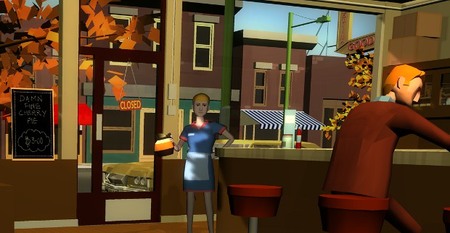Dubbed “Britain’s E3” by me, just now, EGX London (formerly known as the Eurogamer Expo), held every year in London’s un-glamorous Earl’s Court, is a chance to play some of the latest and most interesting games from AAA and independent developers alike. Kudos to the organisers for allocating such a large amount of space to small and first-time game-makers—without their dedication to talent spotting and inclusion, this list of the ten best games on show at EGX 2014 would consist mainly of half-bothered, sub-marketeering entries about Ubisoft’s Christmas line-up.
Keep an eye out for these in the coming year. And yes, this is in no particular order.
1. OlliOlli 2
A superb looking sequel to this year’s PS Vita sleeper hit, OlliOlli 2, by London’s Roll7, was in pre-alpha when I tried it out. A compulsive, colorful skateboard game, OlliOlli 2 combines the twitch reflex mechanics of an endless runner with the point scoring of the old Tony Hawk titles. Using the X button and the left analogue stick, you skate across a beautifully designed 2D cityscape grinding rails, nailing tricks and trying to execute perfect landings. To complete every objective in a level, you have to replay it over and over again, learning exactly where and when to launch your jumps and which pieces of scenery you need to hit in order to find things like hidden collectibles. That focus on aesthetics and level design—the idea that what you’re learning here isn’t how to be faster, but more precise—elevates OlliOlli 2 above a lot of its contemporaries. It’s more beautiful than something like Line Runner, but much more rigid, focused and firm than cluttered simulator games like Skate.
2. Virginia
Another game out of Britain, Virginia is by Variable State. In development since early 2014, this is a first-person exploration game, heavily inspired by ‘90s TV shows like The X Files and Twin Peaks. You play a freshly graduated FBI agent as she investigates the disappearance of a young woman in the eponymous American state, the pitch being that “in the heart of America, nothing is as it seems.” The developers must have played Brendon Chung’s 30 Flights of Loving, since Virginia makes heavy use of smash cuts, zipping from one location to another in the blink of an eye. The narrative is all told through visual markers. A favourite of mine comes in the opening scene, where the Bureau’s chief simply hands you a black and white photograph of the missing girl. Rarely in videogames is story told this neatly, this efficiently. Virginia eschews dialogue and collectible diaries, instead using imagery and smart editing to keep players up to speed. An economic, understated supernatural mystery, Virginia has an energy unmatched by gaming’s other narrative heavyweights. Pick this up in 2015.
3. How to be a Tree

When I sat down at the terminal to try this out, I was expecting some slight, pseudo-intelligent “experiment” in the vein of Mountain. But How to be a Tree is both funny and complex. It poses a dilemma: are you a rebel or a conformist? There are multiple narrative branches, pun intended, and the route you take through them depends on whether you’ll behave like a proper tree, keeping your hands off the controls and just waiting around, or hammer the directional buttons and start moving about, in a style similar to Bennett Foddy’s QWOP. That question of conformity hangs heavy throughout. This is a videogame after all, and as has been highlighted in various titles over the past seven years, games often involve tension between developer and player. Do people want to do as they’re told and get the story as written, or go their own path, disobey the creators and try to forge something unique? What’s the right way to play a game? How to be a Tree humorously poses that question.
4. LA Cops
LA Cops is bound to draw comparisons to Hotline Miami. But where that game is about speed and recklessness, a style of gameplay in keeping with its hallucinatory aesthetic, LA Cops is a heavy, plodding shooter, a suitably mundane affair. I say suitably because outside of the action, the game focuses on the inner lives of six Los Angeles detectives, who are variously going through divorce, financial struggles and career fatigue. They’re overtly and deliberately stereotypes, but the stripped back art style and punchy dialogue are enough to make you care about these characters. Like their faces, which lack distinguishing features, their conversations are largely empty—routine cop schtick about donuts and drug busts. Perhaps I’m being generous, but it feels like this is intended to give players a sense of dissatisfaction, an insight into the humdrum, unfulfilling day jobs these characters inhabit. The shooting mechanics, clunky and sluggish, speak to those themes as well. The violence is bloody, but in gunfights your characters have a kind of low energy, moving and firing very slowly. I’ll have to play the whole way through, but this seems like a game mainly about people who are bored, and that’s something I haven’t seen before.
5. The Room 3
The breakout iOS puzzle game is returning, and it’s more frightening than ever. Well, maybe not frightening, but atmospheric, eerie even. Developer Fireproof Games has consistently mixed surrealism with grounded puzzle design, combining dark, fairytale narrative with tactile, sensible touch-sensitive mechanics. Case in point is one of the sections in The Room 3. You’re trying to open a portal to some kind of Otherworld. There’s an old dry plate camera propped in the center of the room, and some gadget on a desk with a couple of dials and an audio spectrum. After inspecting the camera you find a compartment. Open it up, and there’s a vacuum tube inside. You have to plug that into the machine on the desk and spin the knobs until it whirs and glows back to life. You then stick it back in the camera, fully charged and zap, the portal opens. It’s a unique aesthetic. The magical leaps are tempered by the believable clicks and rattles of the objects you interact with. A very smart game, as you’d expect, The Room 3 launches spring, 2015.
6. Elite: Dangerous
A modern retooling of David Braben’s seminal Spectrum space adventure, Elite: Dangerous was available to play at EGX with the Oculus Rift and some specially made joystick and driving controls. I don’t know if you should shell out for all that gear when the game launches, but it was a hell of an experience, even for 15 minutes. At one point the instructor guy asked me to stand up and turn my head around as much as I could. Behind me I could see the door out of my spaceship’s cockpit; in front were my character’s arms and below, my feet. I’ve had a few goes with the Rift but this was the first time I really felt like it was worthwhile—on other occasions, it was kind of gimmicky. Elite: Dangerous is just the perfect game for it. It’s set in space, obviously, so everything you fly past is new and astounding. The cockpit lets you see all around and above you, so when you aren’t craning your neck to clock an incoming enemy, you can gaze, idly, out at the cosmos. I’m told that the sections of space you explore in the game are accurately modelled on photographs taken by NASA telescopes, meaning that what you fly through is, more or less, what’s actually out there. Without wanting to sound like an advertising campaign, how amazing is that? Maybe I will get a Rift after all…
7. Big Pharma
This is a bit like RollerCoaster Tycoon, or Sim City, except you play as a pharmaceutical company. Perhaps developer Tim Wicksteed would consider renaming it “Theme Bastard.” Actually, no. What I like about Big Pharma is that it refuses to draw any easy moral lines. Just as something like The Wire examines the root causes and professional pressures that breed bad police work, in Big Pharma you soon discover that in order to keep afloat, and continue research on the cure for some life-threatening illness, you have to turn a profit from garbage like skin creams and Tamiflu. The game refuses to offer any trite solutions—it’s savvy enough to know that the problems concordant with the pharmaceutical trade are not the result of just one thing. The magnates aren’t evil, but nor are they philanthropists. That elevates Big Pharma above something like Game Dev Tycoon, a cynical little game where the only way to get ahead is to shill for corporations. There’s some work left to go on Big Pharma but it has journalistic standards beyond most politically-lilted videogames. It’s not propaganda, but it’s not hands-off either. From what I can tell, it’s an objective look at the realities of business.
8. Alien: Isolation
Despite the effort Creative Assembly has made to reproduce Michael Seymour’s production design, I’m hesitant to say Isolation captures much of the feel of the original Alien film. That was a horror movie where the human characters, not the creature were the pursuers—where the monster was the one being chased. In Isolation, it’s definitely you, the player, who is being hunted. And by God that fucking alien just does not let up. On the surface this looks like another of the Amnesia / Outlast style run-and-hide games, where you’re chased by a monster, or monsters, that you’re unable to kill. But Isolation is slightly more complicated, and it makes a world of difference. See, although you can never definitively end the alien, you can scare it off using a blast from your flamethrower, or disorientate it temporarily by popping a distress flare. That creates a much higher level of tension. In Outlast and the rest, since you aren’t given any weapons or tools, you’re implicitly aware that you’ll never have to face your pursuer—the mechanics, paradoxically, are tipped in your favour, since all you have to do is run. In Isolation, however, you do and often will have to physically defend yourself from the alien. Sprint mechanics and conveniently placed wardrobes won’t save you. It’s you versus it. This is the first time I’ve been scared by a videogame since Silent Hill 2.
9. A Light in Chorus
The visuals alone speak for A Light in Chorus—I’m not sure my words can sell it to you any better than this video. It’s a loose exploration game, very much in the vein of Proteus, developed by a pair of British game-makers, Eliott Johnson and Matthew Warshaw. You’re presented with the rough, kind of wireframe outline of what will no doubt be a familiar scene—in the case of my playthrough, a carnival—and have to rearrange items and artifacts until the picture makes sense. For example, at the carnival, some lettering on the neon sign was mixed up, so I stood for a few minutes adjusting it until it correctly spelled out “circus.” Elsewhere, I noticed there was a tree where there ought to have been a concession booth. I wandered into a forested area, found the rogue booth, and swapped it for the tree. As the location started to click together, I could hear the vague sounds of children laughing, music playing—sweet little audio markers that told me I was getting it right. This is a truly beautiful game, built on an engine that Johnson and Warshaw have built themselves from scratch. You’ll definitely be hearing about this one in the future.
10. The Magic Circle
Former Bioshock and Thief designer Jordan Thomas was at EGX to talk through The Magic Circle, an independent project that he’s developing with Stephen Alexander, another former Irrational staffer. You play the hero of an unfinished videogame, stuck inside a world comprised of concept art and untextured surfaces. Frustrated with the fictional developers’ negligence, you take matters into your own hands, and can decide whether to try to finish the game yourself or destroy it from within. You’re able to hack into assets and enemy creatures and alter their behaviours—during his stage demo, Thomas peered into the “mind” of a rock, made it sentient and, just for fun, programmed it to attack other rocks. He concluded by manipulating all of the mushrooms in the game so that they would fly, breath fire and protect him from other enemies. It’s a fantastic combination of debate, once again over who should be in control, the developer or the player, and the unique brand of humor which lives in videogames—you can imagine the player-character as a kind of living glitch, tearing around the game world, screwing things up just for fun. Beautifully styled and clearly influenced by Thomas and Alexander’s personal experiences making games, The Magic Circle is bound to spark debate.








